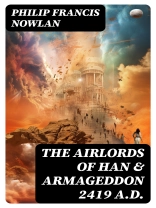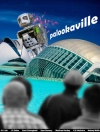In ‘The Airlords of Han’ and ‘Armageddon 2419 A.D., ‘ Philip Francis Nowlan creates a compelling narrative grounded in speculative fiction and early science fiction motifs. Set in a post-apocalyptic future, these tales explore themes of imperialism, technological advancement, and the struggle for freedom against oppressive forces. Nowlan’s literary style mashes vivid descriptions with action-driven prose, embodying the serial storytelling popular in the early 20th century, allowing readers to immerse themselves in a richly constructed world shaped by both Mars and the socio-political dynamics of an alternate Earth. This dual narrative not only captivates the readers with its adventurous spirit but also serves as a commentary on contemporary societal tensions of his time. Nowlan, an influential figure in early speculative fiction, is credited with shaping the genre through works that blend science fiction with elements of adventure and romance. His experiences and interests in technology and societal change during the early 20th century likely spurred his exploration of a dystopian landscape where humanity grapples with the consequences of its own technological innovations. This background, combined with his penchant for inventive storytelling, undoubtedly contributed to the creation of the thrilling narratives in these texts. Recommended for aficionados of classic science fiction and newcomers alike, ‘The Airlords of Han’ and ‘Armageddon 2419 A.D.’ offer a fascinating glimpse into the past that still echoes through the genre today. Readers will find themselves captivated by Nowlan’s imaginative world-building and the ethical dilemmas faced by his characters. These works not only serve as a historical landmark in the evolution of science fiction but also provide timeless reflections on humanity’s resilience in the face of adversity.
เกี่ยวกับผู้แต่ง
Philip Francis Nowlan (1888–1940) was a pivotal figure in the development of early science fiction literature. His most renowned contribution to the genre is the creation of ‘Buck Rogers’, a character who first appeared in Nowlan’s novella ‘Armageddon 2419 A.D.’ published in the August 1928 issue of the pulp magazine Amazing Stories. This seminal work presented readers with a vivid depiction of a future America recovering from a devastating invasion by the ‘Han’, technologically advanced Mongol descendants. Nowlan further explored this universe in the sequel, ‘The Airlords of Han’, which continued the adventures of his intrepid hero. His literary style showcased his forward-thinking imagination, encapsulating themes of technological innovation and societal change that would become cornerstones of science fiction. Though not prolific as some of his contemporaries, Nowlan’s lean, action-driven prose and his vision of a futuristic world wrought with conflict and the struggle for freedom had a lasting impact on the genre, laying the groundwork for the ‘space opera’ subgenre and influencing countless later works. His legacy is embedded in the rich tapestry of science fiction’s history, and Buck Rogers remains an iconic figure that has transcended the boundaries of literature into other media including comic strips, movies, and television.












